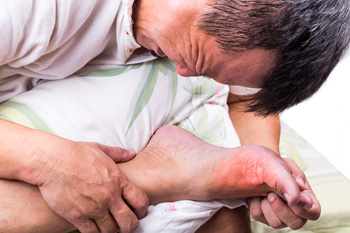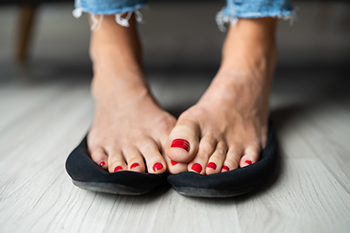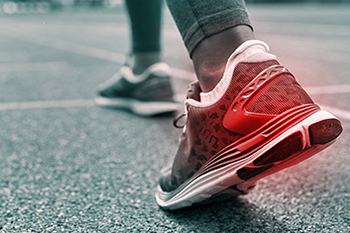Items filtered by date: November 2022
Athlete's Foot or Dry Skin?

Anyone who is conscious about maintaining the health of their feet ought to be familiar with the important differences between mere dry skin on the feet and a case of athlete’s foot. The former condition does not always imply the existence of the latter. For example, if you have dry skin on your feet, you might notice a rough texture and even itching sensations. Sometimes dry skin is accompanied by cracked heels, also known as heel fissures. Athlete’s foot, on the other hand, is a kind of fungal infection that creates a red rash. Athlete’s foot can be contracted by walking around barefoot in highly trafficked public places, like locker rooms. Importantly, it is possible to have both dry skin and athlete’s foot at the same time. For more information about the difference between athlete’s foot and dry skin, contact a podiatrist today. This foot specialist will be able to answer any questions you might have.
Athlete’s foot is an inconvenient condition that can be easily reduced with the proper treatment. If you have any concerns about your feet and ankles, contact one of our podiatrists from Pennsylvania. Our doctors will treat your foot and ankle needs.
Athlete’s Foot: The Sole Story
Athlete's foot, also known as tinea pedis, can be an extremely contagious foot infection. It is commonly contracted in public changing areas and bathrooms, dormitory style living quarters, around locker rooms and public swimming pools, or anywhere your feet often come into contact with other people.
Solutions to Combat Athlete’s Foot
- Hydrate your feet by using lotion
- Exfoliate
- Buff off nails
- Use of anti-fungal products
- Examine your feet and visit your doctor if any suspicious blisters or cuts develop
Athlete’s foot can cause many irritating symptoms such as dry and flaking skin, itching, and redness. Some more severe symptoms can include bleeding and cracked skin, intense itching and burning, and even pain when walking. In the worst cases, Athlete’s foot can cause blistering as well. Speak to your podiatrist for a better understanding of the different causes of Athlete’s foot, as well as help in determining which treatment options are best for you.
If you have any questions please feel free to contact one of our offices located in Plymouth Meeting and Ambler, PA . We offer the newest diagnostic and treatment technologies for all your foot and ankle needs.
Gout Often Begins in the Big Toe

People who have pain in the joints of the big toe may be experiencing a foot condition known as gout. It is caused by excess uric acid in the blood and can come from various reasons. These include genetic factors or eating foods that have elevated amounts of purines. In certain people, purines convert into uric acid which forms crystals in the joints of the toes, generally beginning with the big toe. This can cause considerable pain and discomfort, and it can be difficult for patients to walk when they are affected by gout. Some of the foods that fall into this group of high purine levels include shellfish, red meat, alcohol, and drinks that are made with large amounts of sugar. The pain that gout attacks can cause will often guide patients into developing healthier lifestyle habits. These consist of drinking plenty of water daily, gently performing exercise routines and stretches, and limiting specific types of foods. If you have had gout attacks, it is strongly suggested that you are under the care of a podiatrist who can provide you with expert medical attention for prompt relief.
Gout is a foot condition that requires certain treatment and care. If you are seeking treatment, contact one of our podiatrists from Pennsylvania. Our doctors will treat your foot and ankle needs.
What Is Gout?
Gout is a type of arthritis caused by a buildup of uric acid in the bloodstream. It often develops in the foot, especially the big toe area, although it can manifest in other parts of the body as well. Gout can make walking and standing very painful and is especially common in diabetics and the obese.
People typically get gout because of a poor diet. Genetic predisposition is also a factor. The children of parents who have had gout frequently have a chance of developing it themselves.
Gout can easily be identified by redness and inflammation of the big toe and the surrounding areas of the foot. Other symptoms include extreme fatigue, joint pain, and running high fevers. Sometimes corticosteroid drugs can be prescribed to treat gout, but the best way to combat this disease is to get more exercise and eat a better diet.
If you have any questions please feel free to contact one of our offices located in Plymouth Meeting and Ambler, PA . We offer the newest diagnostic and treatment technologies for all your foot and ankle needs.
Understanding Why Your Feet Sweat

Sweating, or perspiring, is a natural way that the body controls its temperature to keep it from getting too hot. However, some people have overactive sweat glands, which is a condition known as hyperhidrosis. The cause is largely unknown, but thought to be related to genetics. In some cases, underlying medical conditions may be a cause. Hyperhidrosis is more common in younger men than in women. One of the places where this condition can present particular problems is in the feet. They can get slippery within the shoes, which breaks down the skin and allows infections to develop. Foot odor may occur, causing social embarrassment and stress. If your feet sweat excessively, it is a good idea to consult a podiatrist for help in controlling the condition. Among the options for combating sweaty feet are antiperspirants, botox injections, oral medication, and in certain cases surgery to remove the sweat glands.
If you are suffering from hyperhidrosis contact one of our podiatrists of Pennsylvania. Our doctors can provide the care you need to attend to all of your foot and ankle needs.
Hyperhidrosis of the Feet
Hyperhidrosis is a rare disorder that can cause people to have excessive sweating of their feet. This can usually occur all on its own without rigorous activity involved. People who suffer from hyperhidrosis may also experience sweaty palms.
Although it is said that sweating is a healthy process meant to cool down the body temperature and to maintain a proper internal temperature, hyperhidrosis may prove to be a huge hindrance on a person’s everyday life.
Plantar hyperhidrosis is considered to be the main form of hyperhidrosis. Secondary hyperhidrosis can refer to sweating that occurs in areas other than the feet or hands and armpits. Often this may be a sign of it being related to another medical condition such as menopause, hyperthyroidism and even Parkinson’s disease.
In order to alleviate this condition, it is important to see your doctor so that they may prescribe the necessary medications so that you can begin to live a normal life again. If this is left untreated, it is said that it will persist throughout an individual’s life.
A last resort approach would be surgery, but it is best to speak with your doctor to find out what may be the best treatment for you.
If you have any questions please feel free to contact one of our offices located in Plymouth Meeting and Ambler, PA . We offer the newest diagnostic and treatment technologies for all your foot and ankle needs.
Arthritis Can Cause Pain in the Feet and Ankles
Children and Possible Fall Prevention Techniques

As children grow, it is important to create a safe home for them in order to reduce the risk of them falling and injuring themselves. Certain precautions can be useful to aid in this. If you choose to have screened windows, it is important to have them properly installed, as this may prevent children from accidentally falling out. Be mindful to open the window from the top, if possible, so as to bring added safety for children. It is also helpful if existing chairs are removed near the windows to stop the child from climbing up and falling out of the window. Another crucial prevention technique is to ensure children are strapped in while in high chairs, strollers, swings, and infant carriers. This may help to prevent them from attempting to stand up, falling out, and possibly hurting themselves. Research has indicated that baby walkers may be dangerous, and can roll down the steps if the baby moves too close to them. An acceptable alternative may be using a stationary activity center to give the child a chance to stand without possibly falling. If you would like information about how falling can affect children’s feet, and how to safely reduce your child’s chances of falling, please confer with a podiatrist.
Preventing falls among the elderly is very important. If you are older and have fallen or fear that you are prone to falling, consult with one of our podiatrists from Pennsylvania. Our doctors will assess your condition and provide you with quality advice and care.
Every 11 seconds, an elderly American is being treated in an emergency room for a fall related injury. Falls are the leading cause of head and hip injuries for those 65 and older. Due to decreases in strength, balance, senses, and lack of awareness, elderly persons are very susceptible to falling. Thankfully, there are a number of things older persons can do to prevent falls.
How to Prevent Falls
Some effective methods that older persons can do to prevent falls include:
- Enrolling in strength and balance exercise program to increase balance and strength
- Periodically having your sight and hearing checked
- Discuss any medications you have with a doctor to see if it increases the risk of falling
- Clearing the house of falling hazards and installing devices like grab bars and railings
- Utilizing a walker or cane
- Wearing shoes that provide good support and cushioning
- Talking to family members about falling and increasing awareness
Falling can be a traumatic and embarrassing experience for elderly persons; this can make them less willing to leave the house, and less willing to talk to someone about their fears of falling. Doing such things, however, will increase the likelihood of tripping or losing one’s balance. Knowing the causes of falling and how to prevent them is the best way to mitigate the risk of serious injury.
If you have any questions, please feel free to contact one of our offices located in Plymouth Meeting and Ambler, PA . We offer the newest diagnostic and treatment technologies for all your foot care needs.
Finding the Right Activity Shoes for Seniors

Many health experts suggest that exercising is essential for older adults, because the tendency to become sedentary can contribute to a physical, as well as emotional, decline. Building strength, flexibility, endurance, and balance are among the activities recommended for older adults. However, seniors also must take care of their feet while engaging in physical activities that call for standing and walking. First, it’s essential to choose footwear that is made for the type of activity taking place. It is also suggested that footwear should have non-skid flat soles and a cushioned arch that is not too thin or too thick. Additionally, shoes should have adequate heel support and a roomy toe box. Fit is also important when selecting activity footwear. Be sure to have your feet measured properly before buying them, as foot size tends to change with age. Keeping track of the wear and tear on your footwear is a must. Replace shoes when the tread wears out, or if your feet begin to ache or feel tired after exercising. For additional information on finding the right shoes for your activity, please consult a podiatrist.
It is important to find shoes that fit you properly in order to avoid a variety of different foot problems. For more information about treatment, contact one of our podiatrists from Pennsylvania. Our doctors will treat your foot and ankle needs.
Proper Shoe Fitting
Shoes have many different functions. They cushion our body weight, protect our feet, and allow us to safely play sports. You should always make sure that the shoes you wear fit you properly in order to avoid injuries and deformities such as: bunions, corns, calluses, hammertoes, plantar fasciitis, stress fractures, and more. It is important to note that although a certain pair of shoes might be a great fit for someone else, that doesn’t mean they will be a great fit for you. This is why you should always try on shoes before buying them to make sure they are worth the investment. Typically, shoes need to be replaced ever six months to one year of regular use.
Tips for Proper Shoe Fitting
- Select a shoe that is shaped like your foot
- Don’t buy shoes that fit too tight, expecting them to stretch to fit
- Make sure there is enough space (3/8” to ½”) for your longest toe at the end of each shoe when you are standing up
- Walk in the shoes to make sure they fit and feel right
- Don’t select shoes by the size marked inside the shoe, but by how the shoe fits your foot
The shoes you buy should always feel as good as they look. Shoes that fit properly will last longer, feel better, and improve your way of life each day.
If you have any questions, please feel free to contact one of our offices located in Plymouth Meeting and Ambler, PA . We offer the newest diagnostic and treatment technologies for all your foot care needs.

